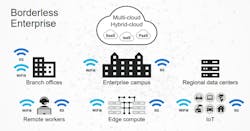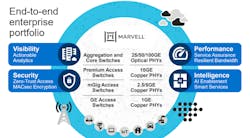Marvell Rolls Out Networking Switch Chips for Edge Computing Era
Marvell Technology rolled out its latest line of networking switch chips and Ethernet PHYs as it fights Broadcom in the market for chips used to manage sprawling corporate networks.
The Santa Clara, California-based company introduced its new generation of Prestera ASICs and Alaska PHYs to more securely and more efficiently move data over enterprise networks. Marvell said it improved the overall throughput of the switch silicon, which can be used in the access to the core layers of the network. It also retooled the technology in the chips to add more intelligence to switches and give companies more visibility into their networks.
"We are leveraging key innovations in the pillars we define as visibility, security, intelligence and performance," said John Chiang, who leads product marketing for Marvell's networking and switching business. He added that its largest rival, Broadcom, has rolled out switching chips with the same feature sets for the data center and the cloud. But he contends that Broadcom has struggled to scale them down for use on the edge of corporate networks.
"We optimized our products for the scale and performance of the intelligent edge," he said. Potential customers for its new generation of Prestera switches and Ethernet PHYs include networking gear makers such as Cisco Systems, Hewlett Packard Enterprise, and Juniper Networks, which sometimes use merchant silicon and sometimes design chips in-house.
Marvell is the second largest networking chip vendor behind Broadcom, which dominates the market for switches used in the sprawling data centers of cloud computing giants like Microsoft and Amazon, and other Silicon Valley titans. Broadcom's Tomahawk chips are the current gold standard in cloud data centers, capable of moving up to 25.6 Tbps. It has also rolled out the Trident family of chips that scale from 2 Tbps to 12.8 Tbps for the enterprise.
But Marvell is trying to strengthen its stronghold in the market for access switches, which are used by small businesses and large corporations alike to connect computers, sensors and other devices at the edge of their network. The family of Prestera chips feature 24 to 192 ports each supporting 1 Gbps to 400 Gbps Ethernet (GbE). The processors supply 28 Gbps to 12.8 Tbps of total throughput and can be paired with corresponding Alaska PHYs.
The Silicon Valley company said it upgraded the networking chips to handle the fire hose of information from the Internet of Things. More than 41.6 billion sensors, cameras, and other devices could be slapped on street lights, stores, factory equipment, cars, bridges, buildings, and other things by 2025, according to market researcher IDC. The rollout of WiFi 6 and 5G technology is also adding to the data deluge, bringing faster data transfers to more devices.
To shoulder the swelling communications load, companies are changing the way they build out their internal networks. Marvell said that instead of sending the out to the cloud, they are rolling out networking gear and other computer hardware to very edge of the network, where the data can be processed on or close to the device where it is produced. That not only reduces latency but it also saves bandwidth between the edge device and the cloud.
"Edge processing helps prevent the need for moving massive amounts of data across the network," said George Hervey, principal system architect at Marvell, in a recent blog. Edge computing also opens the door to new services, such as predicting costly mechanical faults in manufacturing tools and automated inventory management in brick-and-mortar stores.
But as companies collect more data from sensors and other devices, they are also trying to move it all faster. They have started to supplement their increasingly vast internal networks, adding switches and other networking gear that can handle 2.5 Gbps, 5 Gbps, and 10 Gbps Ethernet. They are also upgrading to networking switches that can secure more of the data moving on the network and use artificial intelligence to fix outages and other slowdowns.
Marvell said the new line of Prestera ASICs and Alaska Ethernet PHYs is the industry's most complete portfolio of networking chips for what it called "the borderless enterprise." Marvell said the new networking-switch chips pump out up to 400 Gbps of throughput per port, and the Ethernet PHYs support speeds of 10 Mbps to 400 Gbps on optical or copper cabling.
Marvell said the Prestera ASICs are based on a single scalable architecture so that they can be used in the access, aggregation and core layers of the network. The chips can be slapped on access switches in the wiring closets of small businesses or gateways that aggregate data from sensors and push insights out to the cloud. They can also be used in the core layer of the network: for instance, a floor filled with servers in a company's headquarters.
The networking chips are designed to meet the demands of network architectures at small, medium and large enterprises. Marvell said the chips also integrate programmable pipeline processing cores, giving companies the ability to roll out more features in the future. Under the hood, the networking chips are based on a set of technology building blocks—called NetIQ, SecureIQ, and TrackIQ—that enable more advanced edge computing capabilities.
Marvell said the switch chips include Cortex-A and Cortex-M cores to process more of the data at the edge of the network before feeding it to private data centers or the public cloud. That costs less bandwidth and reduces latency, the company said. Marvell said the NetIQ technology is also there to carry out artificial intelligence chores to identify and fix outages, failures, breaches, and other problems—or offload edge computing services.
"If we parallel cloud data centers, we see that one way to scale out and handle that added bandwidth and number of nodes is to add processing on the network edge," Hervey said.
Marvell has introduced another set of tools that it calls SecureIQ to protect hardware and network software from hackers. The chips integrate secure boot, which prevents the device from booting up if it has been compromised, and 256-bit MACsec technology, which is used to authenticate information as it enters the networking switch and encrypt it on the way out. There are also programmable sensors embedded in the switch chips to spot vulnerabilities.
It has also rolled out technology to protect networks from malicious software and prevent them from being overwhelmed with data in digital assaults called denial-of-service attacks.
The switching chips also incorporate tools for scanning information as it moves through the switch. Marvell said the TrackIQ technology monitors the data as it enters the network and before it leaves, reporting the status of the network to software tools that can identify and troubleshoot any slowdowns, outages, or other issues. That could help companies resolve problems in the network faster and more efficiently handle huge amounts of data.
Marvell said it offers its networking software stack to take advantage of the new features. The company has also rolled out tools that lower the bar for customers to swap out chips from competing vendors. The Silicon Valley company said the new chips support the open networking operating system Dent, which is based on Linux, as well as the Open Compute Project's Sonic OS, which is designed to fit the demands of cloud servers and data centers.
Marvell said the first products in its family of Prestera switches and Alaska PHYs are now available. The complete portfolio of product should be on sale before the end of the year.
About the Author
James Morra
Senior Editor
James Morra is the senior editor for Electronic Design, covering the semiconductor industry and new technology trends, with a focus on power electronics and power management. He also reports on the business behind electrical engineering, including the electronics supply chain. He joined Electronic Design in 2015 and is based in Chicago, Illinois.





